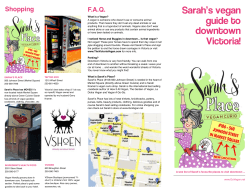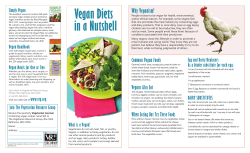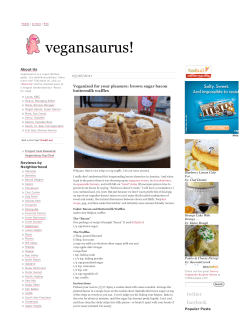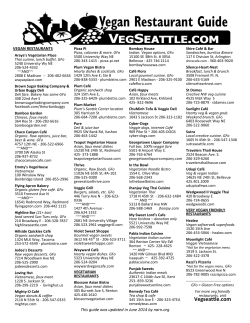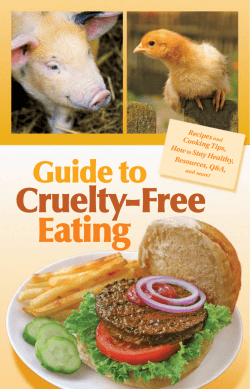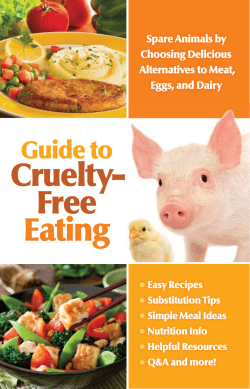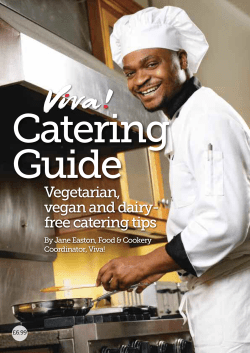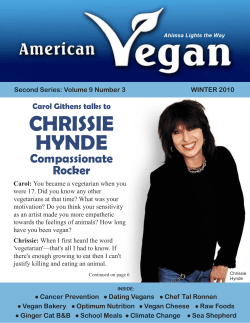
Document 78749
THREE GREAT REASONS TO BECOME VEGAN 1 ANIMALS WILL BE SAVED Turning animals into food causes horrific suffering and the slaughter of billions of lives every year. Being vegan is the best way to ‘vote with your dollar’ and to make sure you don’t cause anyone’s slavery, torment and death. 2 YOU’LL BE HEALTHIER Cut out animal fat, don’t chew it! By becoming vegan you’ll reduce your risk of many major illnesses, including heart disease, diabetes, colon cancer, obesity, osteoporosis and high cholesterol. This positive lifestyle will give you energy, enthusiasm and good health. 3 THE EARTH WILL BE CLEANER The production and waste from processing billions of animals into food and dairy every year is a significant cause of global pollution and climate breakdown. By choosing to be vegan you’ll be contributing daily, with each bite you take, to a cleaner and kinder world. Merryn Redenbach Doctor Vegan 2002 I am vegan… The animals we live beside on our amazing planet should be afforded the same respect that we aspire to afford to all humans. MEET SOME VEGANS Sofia Todorova Law Student Vegan 2010 I am vegan… Animals suffer unconscionable abuses. Protecting their interests is the least I can do. Robin Tullett Endurance Athlete Vegan 2011 I am vegan… It is the best action anyone can take to reduce suffering in the world. Billy Simmonds Natural Mr Universe Vegan 2011 I am vegan… You really can’t deny it’s the right choice, in terms of your health, the environment and the impact you’re having on other living beings. Adalita Musician Vegan 1999 I am vegan… I was shocked and saddened to learn about what happens to female cows and calves in the dairy industry. Madeline Kallista Nurse and Athlete Vegan 2011 I am vegan… As a mother my most important role is to protect, I do not restrict that to my own son or species Max Kallista Toddler Vegan Since 2011 I am vegan… My mum and dad want me to be a conscious, happy and healthy kid. Philip Wollen OAM Merchant Banker, Philanthropist Vegan 2000 I am vegan… I love life in all its forms. Meat and milk are four letter words for good reason. They kill. Fawn Porter Sharon Scott Vegan 2008 I am vegan… I believe we can live Vegan 1994 I am vegan… I Personal Trainer Firefighter sustainable and abundantly healthy lives where our choices reflect compassion to all. don’t need to be any other way to be happy, healthy and to enjoy life! Daniel Ferguson Science Student Vegan 2009 I am vegan… I believe every creature has inherent value and the right to live. AGEISM HOMOPHOBIA SEXISM RACISM SPECIESISM We are all familiar with racism and sexism and the suffering and injustice such prejudices cause. This human meat tray is a confronting image - just like seeing a row of handcuffed human slaves on an auction block would be. Society is moving forward against racism and sexism, it’s time we also stop speciesism. Animals are not ours. Members of every race, sex and species are individual sentient beings. Whatever colour our skin may be; whether we are male or female; whether we have fur, feathers, scales or skin, we feel pain and pleasure. All life is interconnected and for one species to enslave and kill billions of others for their own purposes destroys biodiversity and the balance of nature. A healthy and sustainable world respects the lives of all who live there. While we continue to regard animals as property, as personal possessions to do with whatever we want, we are still in the dark ages. Cross another unjust prejudice off your list. TURNING ANIMALS INTO FOOD DEATH TOLL: 58 BILLION EACH YEAR AND RISING (NOT INCLUDING TRILLIONS OF WATER ANIMALS) Humans are an amazing and intelligent species, our capabilities are enormous. We fly to the moon, build computers and skyscrapers, read, write, paint, cure diseases and compose masterpieces. Yet, we are without doubt the most bloodthirsty and violent species on the planet. There are over 7 billion humans on Earth and counting, and every year we raise and kill 58 billion land animals to eat. Plus we are draining the oceans of fish. Each year we catch and kill between 1 - 3 TRILLION of them, and feed over 30% of our catch to the land animals we eat. How wonderful it is that nobody need wait a single moment before starting to improve the world. Anne Frank, Nazi Holocaust victim Humans are the only species (out of 8.7 million) on the planet to design, build and operate massive killing centres called abattoirs or slaughterhouses where we routinely murder billions upon billions of animals. These terrified individuals are forced to stand or hang in queues watching and waiting for their turn to come. This little lamb was born at the abattoir while his mother was waiting for slaughter – a regular occurrence. NEITHER THE CHICKEN OR THE EGG COMES FIRST Chicken production is soaring, but the birds aren’t. Never before on planet Earth has there been so many chickens. 90% of the land animals we kill each year for food are chickens. There are two types of chickens that humans now mass produce: laying hens who are raised solely to lay eggs and broilers, chickens produced only for their flesh. Chicken meat consumption in Australia has jumped to 33 kilos of chicken meat per person per year, and laying hens now lay 320 eggs a year instead of the 20 nature intended. & LAYING HEN BROILER CHICK Laying hens are kept either in cages, sheds or semioutdoors (called free-range). Their parents (called breeders by the industry) are always packed tightly indoors where the hens become red and raw from constant mating. They never see their offspring who are artificially hatched in industrial incubators. Half of the chicks are male and won’t lay eggs so they are gassed or ground up alive at day one. Laying hens aren’t ‘profitable’ after eighteen months of age so are killed instead of living their 8-10 year lifespan. Their depleted bodies are used for pet food, stock cubes or fertilizer. Broiler chickens are lame, crippled and/or sickly chicks who are killed when 6 - 8 weeks of age but already heavier than an average adult laying hen. They are selected for fast growth and fed antibiotics daily to keep them alive and to speed growth. Their bones can’t keep up with the abnormal growth rates - it’s like putting a teenager’s weight on toddlers’ legs. The chicks are packed tightly inside large industrial sheds holding 40,000 - 65,000 birds. Their excrement builds up, the smell is overwhelming, the ammonia burns their eyes. Their parents never see the light of day either, but their torment lasts sixty weeks. COWS – CHEWED UP AND SUCKED DRY Cows have miserable lives. They are routinely desexed, dehorned and hot-iron branded without any pain relief. Feedlots for both meat and dairy cows are now widespread. The confined animals either stand deep in muddy excrement or suffer dust, flies and relentless heat from a blazing sun. The journey to saleyard and slaughterhouse is long and traumatic without food or water. In the killing line, cows are fully aware of what lies ahead. They are terrified, kicking and screaming. They foam at the mouth in the kill box from fear as the slaughterman takes aim between their eyes. Cows too sick or injured to stand are often dragged with chains to the killing floor, or left to slowly die. VI VA ! Cows are intelligent animals who form lifelong bonds with each other. A cow naturally lives for around 25 years, yet meat cattle are killed when one or two and dairy cows around three years of age. o: ot Ph DAIRY – A SLAUGHTER INDUSTRY Cows only produce milk when they have a calf. Dairy cows are artificially impregnated to produce milk for humans while their babies are killed. Cows and their calves are separated at birth. Mums will break down fences and walk miles to reunite with their babies. Both bellow and cry for days to be reunited. Dairy cows are forced into a relentless cycle of pregnancy, birthing and milk production. They suffer chronic mastitis, lameness, severe liver damage and painful digestive disorders. Male calves and surplus females are reared for veal or immediately slaughtered. Millions of cows and their calves are killed every year so humans can consume dairy products. WAITING TO DIE This sow is broken, defeated, exhausted, humiliated, mutilated and waiting to die. She is typical of mother pigs who give birth to some 6,000,000 pigs slaughtered every year in Australia. Piglets are killed when five months old, their mother’s lifespan depends on how long her body can withstand constant pregnancy, confinement, depression and deprivation. Pigs are sociable, affectionate, strong-willed individuals who form strong bonds with family and friends, just like we do. “The killing of free range pigs at the slaughterhouse was particularly distressing. One pig was absolutely terrified, screaming and frothing at the mouth. She could see pigs bleeding out before her. She twisted and turned her body desperately trying to escape. The slaughterman panicked and planted the electrical stunner on her head so tightly that smoke rose. Her eyes caught mine in sheer terror and pain - more than anything I wanted to get her out of there.” Patty Mark, Founder Animal Liberation Victoria FISH THE ONES WHO DON’T SCREAM Scientists report that 90 percent of all large fish, including tuna, swordfish, marlin, cod, halibut, skates and flounder — are now GONE from the world’s oceans. The UN’s Food and Agriculture Organisation warns that almost 80 percent of the world’s fisheries are over-exploited, depleted or in a state of collapse. We are as deaf to the sounds of fishes pain as we are blind to our rampant devastation of their home, the seas. Fish are individuals, not resources to plunder. At the current rate of overfishing there will be no fish left in the sea in 40 years. Science Magazine Sylvia Earle, a respected scientist and oceanographer has been at the frontier of deep ocean exploration for four decades. Sylvia is the 2009 TED.com Prize winner for her work to save our oceans. Watch her powerful presentation here: www.alv.org.au/issues/fish.php Fish feel pain, fear and stress. Because they don’t scream, like we would if someone ripped a hook through our mouth and pulled us to our death, doesn’t mean they aren’t suffering. THE EARTH IS IN CRISIS AN ORGANIC VEGAN DIET PRODUCES 94% LESS GREENHOUSE GAS EMISSIONS THAN THE AVERAGE MEAT AND DAIRY DIET. FOODWATCH REPORT (GERMANY 2009) VEGAN YOU CAN'T GET GREENER Check out your ecological footprint at epa.vic.gov.au In Australia, methane emissions from livestock (breathing, burping and flatulence) are greater than the carbon dioxide emissions from all our coal-fired power stations combined. Carbon dioxide takes hundreds of years to break down and disappear from the atmosphere, whereas methane is a short-lived gas and breaks down in the atmosphere after 8 - 10 years. Reducing methane is the key to rapidly cool the planet. CSIRO Perfidy (Russell 2009) The United Nations is calling for a global shift towards a vegan diet to maintain sustainability as the global population heads to 9.1 billion by 2050. Assessing the Environmental Impact of Consumption and Production. United Nations Environment Program (2010) If all the Earth’s tillable land were turned into organic vegetable farmland, not only would people be fully fed, but up to 40% of all CO2 emissions could be absorbed A vegan driving a hummer contributes less greenhouse gas emissions than a meat If everyone on the planet lived like Victorians, we eater riding a bicycle. Rodale Institute, 2008 would need more than four planet Earths to support us. Environmental Protection Agency (VIC) VEGAN HEALTH “... vegan diets are healthful, nutritionally adequate and may provide health benefits in the prevention and treatment of certain diseases, and are appropriate for individuals during all stages of the life-cycle including pregnancy, lactation, infancy, childhood and adolescence and athletes.” The American Dietetic Association, July 2009 Dairy is Bad (make no bones about it) Cut Your Cancer Risk THE BAD Animal proteins like milk leach calcium from bones creating a risk of fracture and osteoporosis. Harvard University followed 78,000 nurses for 12 years and found that women who consumed the most calcium from dairy broke more bones than those who rarely drank milk. THE BAD Consumption of meat and dairy is linked to various forms of cancer, including breast, bowel, ovarian, bladder and lung cancer. “The association between the intake of animal protein and fracture rates appears to be as strong as the association between cigarette smoking and lung cancer.” Dr. T. Colin Campbell, The China Study (2006) THE GOOD To build strong bones and healthy bodies we need exercise, sunshine and a diet rich in plant foods like beans, broccoli, green leafy vegetables, unhulled sesame seeds and tofu - all good sources of calcium. Healthier Hearts THE BAD Cholesterol is found ONLY in animal products and excess is accumulated in our arteries, skin, tendons and other tissue. THE GOOD “A plant-based, oil-free diet can not only prevent and stop the progression of heart disease, but also reverse its effects.”Dr. Caldwell B. Esselstyne Jr. (Bill Clinton credits Dr Esselstyne’s diet for his health recovery) THE GOOD Vegan diets are lower in fat and higher in fibre than meat-based diets. Furthermore, plants contain cancer-fighting substances called phytochemicals. Healthy Kids THE BAD Cow’s milk is the number one source of allergies in children, and research links consumption of dairy products to colic, autism, chronic ear infections, insulin-dependent diabetes mellitus (type 1 or ‘juvenile onset” diabetes), acne, obesity, flatulence, constipation, mucus, and a variety of other ailments. THE GOOD Vegetables, grains, fruits, legumes and nuts are the optimal food for children. Rich in complex carbohydrates, protein, fibre, vitamins and minerals they form the foundation for dietary habits that support a lifetime of health. “The human body has no more need for cows’ milk than it does for dogs’ milk, horses’ milk, or giraffes’ milk.” - Michael Klaper M.D. THE PLANT FOOD GROUPS By Amanda Benham Accredited Practising Dietitian Foods derived from plants can be classified into different groups. Basing our daily diet on a variety of foods from each of the plant food groups will help ensure that our diets are rich in essential nutrients. Aiming to eat mostly “whole” plant foods rather than highly processed foods is recommended. Whole Grains Vegetables Fruit Legumes etc. Whole grains are grains that have not had the outer bran layer or the “germ” part removed. They are more nutritious than refined grains, being richer in vitamins, minerals and fibre. Examples are brown rice, rolled oats, corn, quinoa, and barley. Vegetables are low in fat but rich in essential nutrients. The most important vegetables to eat every day are green vegetables. They are particularly rich in nutrients and health-enhancing components. It is good to eat a variety of different fruits. Try to choose some that are rich in vitamin C such as mango, pineapple, berries and kiwifruit. Fresh, whole fruit is the best choice, as processing fruit destroys valuable nutrients. Legumes such as lentils, chickpeas, kidney beans and baked beans are rich in protein, minerals and fibre. This group includes soy products such as tofu, tempeh and textured vegetable protein (TVP). Products made from wholemeal flour, such as pasta, bread and crackers are also in this group. If choosing breakfast cereals, look for varieties that are 100% wholegrain. It is also important to eat red/ orange/yellow vegetables as these are rich in pro-vitamin A and other health-enhancing antioxidants. Examples include carrots, pumpkin, yellow squash, sweet potato, sweet corn, red and yellow capsicum and tomatoes. Eat a wide variety of nutritious foods from these five food groups every day to ensure you get the nutrients you need. For serving sizes and more information visit www.humanherbivore.com Plant Milks Plant milks include soy milk, almond milk and rice milk. Check the label and choose varieties that have been fortified with added calcium and vitamin B12.* Nuts and seeds can be eaten whole or ground, or in paste form such as peanut butter and tahini (sesame paste). Flaxseeds / linseeds are rich in essential fatty acids, which are reputed to be good for your heart and brain. * If not consuming the recommended amount of fortified plant milk each day, seek other sources of calcium and vitamin B12. Supplementation with Vitamin B12 is essential for all vegans. Vitamins & EFAs Vegetables The only vitamins that are not readily obtainable from unprocessed plant foods are Vitamins B12 and D. It is important for anyone eating a vegan diet to know where to get them. Whole Grains & Cereals Vitamin D - the Sun! 10-30 minutes of daily mild sun exposure, without sunscreen, is recommended. During winter or for those living in less sunny areas Vitamin D supplements are recommended. Vitamin B12 - B12 is produced by bacteria and is found in soil and waterways, but is not normally found in common plant foods. Vegans can obtain vitamin B12 from fortified foods or taking vitamin B12 supplements in lozenge, tablet or spray form. Daily supplementation is recommended. Fruit Legumes, Soy Products, Nuts & Seeds Fortified Plant Milks Omega 3 -Vegans also require a good ratio of essential fatty acids (EFAs), which generally means adding more omega 3 fatty acids to the diet. Alpha linolenic acid (ALA) is obtained from flax seeds (sprinkle 2-3 teaspoons over cereal), chia seeds (make your own pudding) or flax seed oil (drizzle over salads). The other omega 3 fatty acids (EPA and DHA) can be obtained from algae, which is where fish get it from. Algal supplements of EPA and DHA are available. More information available at veganeasy.org and humanherbivore.com SOME VEGAN FAVOURITES! Breakfast Lunch Dinner Porridge or cereal with soy, rice or nut milk and fresh fruit Minestrone soup with crusty bread Vegan lasagne or garlic broccoli penne Vegetable frittata BBQ tofu/veggie skewers with corn on the cob Scrambled tofu with grilled tomatoes and mushroom on toasted English muffin Wholegrain toast with marmite/ avocado/jam or baked beans Fresh fruit salad and soy yoghurt Green smoothie Blueberry, apple or pear muffins Vegan pancakes with maple syrup Tempeh or bean burger Hearty salads using lentils, beans, potatoes, rice or pasta Sandwich or wrap - using a variety of salads, vegan mayonnaise, mustard, houmous, roasted vegetables, falafel, crispy tofu, mock meat slices or vegan schnitzels Avocado or vegan sushi Baked potato topped with mixed beans, veggie salad and tofutti cream cheese Vegetable curry or dahl with garlic roti bread Thai-Style noodles with peanut basil sauce Mixed veggie stir-fry with tofu or tempeh served with rice or noodles Vegan chilli with salad greens and guacamole Mushroom risotto SHOP! Visit health shops, Asian groceries, speciality shops and online stores. Plus, you’ll be surprised at the interesting variety of vegan foods available in your local supermarket. GRAB some vegan cookbooks, there are many available offering appetising recipes ranging from the traditional to the exotic. Here are some great recipes to start you off and check out thousands more online, starting with veganeasy.org INSPIRE yourself and your friends, check out veggie restaurants and cafes in your area and discover the unlimited selection of fine foods vegans enjoy. LEARN all you can about the impact animal agriculture is having on animals and climate breakdown. Learn how to read labels so you know what’s in the food you eat. Fill your tank with fresh wholesome foods not animal fats. PERSIST and remember why you are making this positive change. Being vegan is the best way to better health, a cleaner environment and helping animals. Don’t get frustrated, if you slip up, keep at it, every bite makes a difference. STRENGTH in numbers… hang out with other vegans. There are numerous forums and social groups available for you to meet like minded people. TURN THE PAGE FOR SOME DELICIOUS RECIPES GREEN SMOOTHIE Smoothies are a quick and easy way to get your greens! Don’t be put off by the colour, they are delicious. Blending greens with fruit is a fantastic way to start your day in a super healthy way. Greens are full of iron, calcium and heaps of vitamins and minerals. Blending them makes these nutrients more readily available to your body. The smoothie pictured was made with baby spinach, juiced wheatgrass, curly kale leaves, cucumber, celery apple, pear and ginger. Baby spinach is good to start with as it’s mild, but you can use any greens - try lettuce (not iceburg), bok choy, silverbeet, kale, parsley, carrot tops, beet leaves and more! Add enough of your favourite whole soft fruit to sweeten and blend well. They’re a fun way for kids to get their greens! Our motto is ‘A green smoothie a day keeps the doctor away!’ SCRAMBLED TOFU WHAT TO DO A delicious cruelty free breakfast. Pictured on a toasted English muffin with a grilled Portobello mushroom and tomato wedges. Heat a little olive oil in a frying pan. Fry onion and tofu for a minute or two. Add tamari, yeast flakes, turmeric and water to pan and fry for a further minute. Remove from heat and stir through the fresh herbs. Add cracked black pepper to taste. INGREDIENTS (serves 2) 200g tofu, crumbled 2 spring onions, sliced 2 tsp tamari, or soy sauce 2 tsp savoury yeast flakes ½ tsp turmeric 2-3 tbsp water 1 tbsp chopped fresh parsley or chives Freshly ground pepper Olive oil for frying PIZZA Everyone loves a pizza, and one which isn’t laden with greasy cheese will love you too! We bought a ready made base, although if you’re adventurous you can make your own. Cover with pizza sauce (Leggo’s is vegan) and your favourite toppings. We used onion, mushroom, red capsicum, roast pumpkin, garlic, tomatoes and olives. You could even go wild and add vegan pepperoni and vegan cheese! POTATO, SQUASH & ASPARAGUS FRITTATA Who said you can’t have frittata if you’re vegan! Try capsicum, mushrooms, zucchini or spinach for different varieties. Serve warm with crusty bread and a crisp green salad. WHAT TO DO Fry potatoes and squash until golden brown. Add onion, garlic and dried herbs and continue cooking until onions are soft and brown. Season well with salt and pepper. Add asparagus and cook for a further 2-3 minutes. Tip vegetable mixture into a 20cm springform cake tin. Place tofu and remaining ingredients (except fresh herbs) in a blender/food processer and blend until smooth, stir in fresh herbs. INGREDIENTS (serves 4-6) 400g potatoes, cut in chunks 250g butternut squash, cut in chunks 1 bunch asparagus, cut in thirds 1 large onion, thickly sliced 2 garlic cloves, minced 1 tsp dried mixed herbs 250g tofu ½ cup water 1 tbsp savoury yeast flakes 1 tsp mild paprika 1 tsp Dijon mustard 1 tsp vegan margarine 1 tbsp Tofutti cream ‘cheese’ 1 handful parsley and/or chives, chopped Pour mixture over vegetables and smooth with a knife. Bake in a medium hot oven for 30-40 minutes. ADUKI BURGER WHAT TO DO Instead of a greasy, cholesterol - loaded animal burger, try one of these tasty and healthy bean burgers. Or, if you’re in a hurry grab one of the many veggie burgers readily available instead. Soak aduki beans in water overnight. Drain, rinse and bring to the boil in fresh water, simmer for 40 minutes. Drain and set aside, mash when cool. Fry onion and garlic until golden brown. Add to beans with stock powder, herbs, breadcrumbs, flour and Worcestershire sauce and mix well. Divide mixture into two and shape into burgers. Fry until brown on each side INGREDIENTS (serves 2) ½ cup dry aduki beans 1 red onion, finely diced 2 cloves garlic, crushed 1 tsp Massell ‘beef style’ stock powder ½ tsp dried mixed herbs ½ cup fresh breadcrumbs 1 tbsp plain flour 1 tsp vegan Worcestershire sauce Serve in a bun with your favourite extras. Here we used lettuce, tomato, avocado, tomato sauce, and baked potato wedges on the side. LASAGNE WHAT TO DO Roasted veg and tofu cream cheese lasagne with mozarella Cheezly on top. Preheat oven to 180 degrees Celsius. Thinly slice vegetables, lightly spray with olive oil, place on baking tray and bake till 3/4 cooked. Heat oil in pan over med-high heat, add onions and garlic, sauté for about 4 to 5 minutes, or until golden. Add spinach, cook for about 3 minutes until wilted. INGREDIENTS (serves 4-6) Transfer to bowl of food processor, add tofu, tofutti, basil and nutritional yeast, and blend until smooth. Season with salt and pepper. FILLING 2 tsp olive oil 2 med onions, chopped 3 cloves garlic, minced 1 bag fresh baby spinach 500g tofu, drained 1 tub tofutti 1/2 cup fresh basil, chopped 1/4 cup nutritional yeast Spread pasta sauce over the bottom of lasagne dish. Cover with lasagne sheets then half the spinach filling. LASAGNE 2 bottles pasta sauce 1 packet uncooked lasagne sheets Roasted vegetables of choice (pumpkin, mushrooms & capsicum used here) Block vegan mozzarella cheese (Cheezly used here) Top with grated vegan cheese. Add another layer of lasagne sheets and cover with more pasta sauce. Layer vegetables then add more lasagne sheets and pasta sauce. Spread the rest of the spinach filling, lasagne sheets and pasta sauce. Cover with foil and cook for 30 minutes, uncover and cook for a further 15-30 minutes or until lasagne sheets are tender. CHOCOLATE BROWNIE CHEESECAKE For this recipe and many more visit veganeasy.org VEGAN SWEET TREATS There is a huge and ever increasing variety of vegan ice creams, cakes, sauces, custards, creams, cookies, chocolate, and sprinkles available. Be creative and combine these with some fresh fruit and nuts for a truly scrumptious, decadent dessert. See our dragonfly ice cream cake below for inspiration! FOR MORE INFORMATION Helpful Websites Suggested Reading veganeasy.org Vegan recipes, products, tips and more! Introduction to Animal Rights: Your Child or the Dog? by Professor Gary Francione alv.org.au Animal Liberation Victoria Australia’s premier vegan abolitionist animal rights group The China Study by Dr T Colin Campbell & T M Campbell animalequality.net Spanish based open rescue/abolitionist group abolitionistapproach.com Professor Gary Francione on animal rights philosophy humanemyth.org Deconstructing the myth of humane animal agriculture heartattackproof.com Dr Caldwell B Esselstyn Jr. on healthy living with a plant based diet Why We Love Dogs, Eat Pigs, and Wear Cows by Melanie Joy, Ph.D. Veganomicon: The Ultimate Vegan Cookbook by Isa Chandra Moskowitz Recommended Viewing Earthlings (narrated by Joaquin Phoenix) available from ALV Peaceable Kingdom - The Journey Home tribeofheart.org ANIMAL LIBERATION VICTORIA PO Box 15 Elwood VIC 3184 Australia Phone 03 9531 4367 Email info@alv.org.au Animal rights is a social justice issue. Animals are not property, possessions or slaves. alv.org.au Design Henry Fuller, Noah Hannibal / Ethical Design Photography Anita Frank, Noah Hannibal Thank you to our sponsors uproar.org.au ♥ SAVE LIVES, lighten your ecofootprint and live healthier by making one easy change - become vegan. Join the 30 Day Vegan Easy Challenge. Our Vegan Easy team will be there to guide and support you. Sign up at www.veganeasy.org Philip Wollen Kindness House facebook.com/veganeasy
© Copyright 2025


